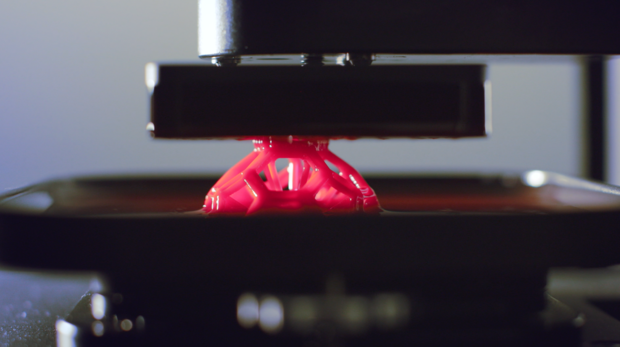
Start-up Carbon began shipping its industrial-grade 3D printer with the expectation that big-name companies will soon be using it to replace traditional forms of manufacturing.
Last year, the Silicon Valley company emerged from quiet mode to announce its technology: a machine that can create objects 25 to 100 times faster than other 3D printers.
Carbon is not selling its M1 3D printer outright, but instead is offering it through a subscription price of $40,000 per year, which includes a service and maintenance plan.
 Carbon
Carbon Similar to existing stereolithography (SLA) rapid prototyping processes, the Carbon M1 3D printer uses an ultraviolet light projector under a light-sensitive resin pool to harden the liquid and then pulls the object from the pool.
The three-year-old company based in Redwood City, Calif. said its Continuous Liquid Interface Production (CLIP) printing process can create objects in minutes compared to the hours a typical 3D printer requires.
Kirk Phelps, Carbon's vice president of product management, said the M1 can print production-ready parts that can achieve price parity with traditional manufacturing methods with runs of up to 45,000 units.
Because the cost of parts is amortized over an entire run, the more parts made, the less each unit costs. So Carbon is estimating price parity for production runs of around 45,000.
"There are lots of applications in the automotive and aerospace industries with 45,000 part runs," Phelps said. Compared to traditional manufacturing methods such as injection molding, 3D printing carries with it no upfront capital costs other than the machine itself. There is no engineering of steel or aluminum tools for each new part runoff and engineering costs are reduced because modifying designs can be done with CAD software that is transferred directly to 3D slicer software for printing.
Similar to existing stereolithography (SLA) rapid prototyping processes, the Carbon M1 3D printer uses an ultraviolet (UV) light projector under a light-sensitive resin pool. As the platform moves upward, the projector moves light along cross sections of the liquid polymer, solidifying it as it goes and forming objects.
The difference between CLIP and traditional SLA is that instead of a UV light or laser drawing the design on each layer of the liquid polymer pool, CLIP projects an entire cross section of the object across the pool, something akin to a slideshow that instantly creates a hardened layer of the object.
"All other 3D printing techniques are just 2D printing over and over again -- hence, the layers and the weaker mechanical properties," Phelps said, referring to the layer-by-layer additive-manufacturing process. " CLIP's process is completely continuous, meaning there are no layers -- growing parts rather than printing them layer by layer."
While traditional approaches to additive manufacturing (3D printing), such as fused filament fabrication (FFF) or selective laser sintering (SLS), make trade-offs between surface finish and mechanical properties, the M1 produces high-resolution parts with engineering-grade mechanical properties and surface finish.
 Carbon
Carbon A pipe printed with Carbon's M1 3D printer.
"This product lays the groundwork for addressing major gaps in additive manufacturing as we work with our customers to continually innovate and push the boundaries of product design and production," Carbon CEO Joseph DeSimone said in a statement.
Phelps compared the M1's production quality to that of injection molding or urethane casting, where molten metal or liquid resin is poured into a cast where it hardens.
Carbon offers seven resins from which the M1 can print objects; the resins range from rigid and semi-rigid materials to high-temperature resistant resins and rubbery plastics that meet the specifications for commercial running shoes.
 Carbon
Carbon A 3D-printed turbine.
For example, Carbon's Cyanate Ester-based resin is a high-performance material with heat deflection up to 219 degrees Celsius (426 degrees Fahrenheit). The Cyanate Ester resin is designed for automotive under-the-hood applications, such as ducting, electronics and other industrial components.
Carbon has been working with beta customers in industries such as auto, aerospace, medical and athletic apparel, including a number of Fortune 500 companies. BMW, for example, uses the M1 3D printer to make the name badges on some of its models, which were formerly produced using injection molded thermoplastic.
Ford has also tested Carbon's M1 for printing engine duct work, Phelps said.
 Carbon
Carbon The difference between Continuous Liquid Interface Production (CLIP) and traditional stereolithography 3D printing is that instead of a UV light or laser drawing the design on each layer of the liquid polymer pool, CLIP projects an entire cross section of the object across the pool.
"With our technology, because we have this incredibly high functional, high temperature material, they're really excited to be printing ducting that performs just like the injection-molded duct," Phelps said.
The M1 is being used to shorten product development cycles, address new lightweight, high-strength geometries, and produce customized medical devices, Carbon said.
"The medical device community is using that material in sterilizable applications," Phelps continued. "I'm not aware of any 3D printer in the world -- SLS included -- that can do something like that."

















